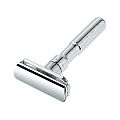Shaving Experience
History
Before the advent of razors, human removed hair using two sea shells to pull the hair out. Around 3,000 BC, when copper tools were developed, men developed copper razors. The idea of an aesthetic approach to personal hygiene may have begun at this time. One of the characters in favour of shaving was Alexander the Great who strongly promoted shaving during his reign in the 4th Century BCE.
Shaving techniques
Shaving can be done using electric razor or a manual razor. If a non-electric razor is used, some lathering or lubricating agent such as shaving cream, soap, gel, foam or shaving oil is normally applied on the face to help avoid painful razor burns and irritations. These grease the area to be shaved, humidify the skin and lift, soften and swell the hairs. This improves the cutting action and sometimes permits shaving the hairs deeper below the surface of the skin.
Current multi-blade cartridges are designed to simplify shaving, but the safety razor continues to be used, and not merely because the blades are much less expensive than cartridges. Shaving with a safety razor requires some practice, but its adherents greatly enjoy it.
Shaving styles
Shaving is normally done with top to bottom downward action of the razor. However, many people prefer the other direction, coming up from the base of the cheek or neck. The latter technique usually results in rough beard growth where the growing hair sticks out horizontally. On the positive side, it gives a cleaner and neater appearance than the conventional shaving style.
Some people, especially those with unique growth patterns will shave from top to bottom, bottom to top, and laterally. A single directional stroke may leave hairs, and this method ensures the removal of the majority of what remains.
Shaving aids
Shaving without using a shaving cream, gel, soap, or oil is known as dry shaving. Electric razors are typically used without external shaving aids, and were originally called dry shavers. However, modern electric razors often lubricate the skin slightly.
The removal of a full beard often requires the use of an electric (or beard) trimmer to reduce the mass of hair, simplifying the process.
Side effects of shaving
Shaving can have numerous side effects, including cuts, abrasions, and irritation. Some people with curly hair have an adverse response to shaving "razor bumps" due to ingrown hairs. Many side effects can be reduced by using a fresh blade, plenty of lubrication, and avoiding pressing down with the razor. Some people choose to use only single-blade or wire-wrapped blades that shave farther away from the skin. Others cannot use razors at all and use depilatory shaving powders to dissolve hair above the skin's surface.
Many people traditionally believed that shaving would cause the hair shaved to become thicker and darker. However, this bit of conventional wisdom has been disproved. The resulting stubble only makes the hairs seem to be thicker, as a shaved hair has a blunt end as opposed to the tapered end of an unshaven hair, and because hair is often darker in colour near the root. Clinical studies have demonstrated that shaving does not have an effect on hair growth rates or density (see medical data below).
Aftershave
Many men use an aftershave lotion after they have finished shaving. It may contain an antiseptic agent such as alcohol to prevent infection from cuts, a perfume to enhance scent, and a moisturizer to soften the skin.
Cuts
Cuts from shaving can bleed for about fifteen minutes. Common ways to stop bleeding include putting alcohol on a cotton swab and pressing it onto the cut until the bleeding stops as well as tearing off a small piece of toilet paper and placing it onto the cut, however, this latter method may be undesirable for aesthetic reasons. Products such as styptic pencils can also be used to stop bleeding; placing a small amount of petroleum jelly on the cut after most of the bleeding has ended stops the bleeding without forming a scab. Shaving in a cold shower can help because blood flow to the skin is reduced in these conditions, due to vasoconstriction caused by the cold water.



